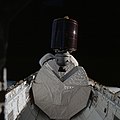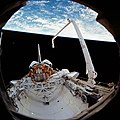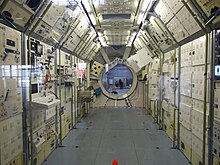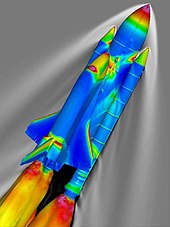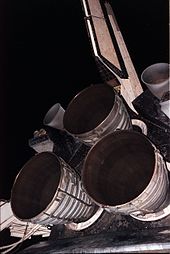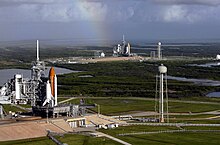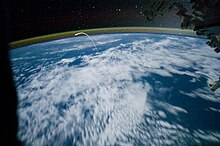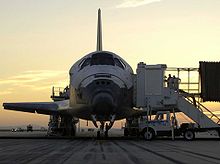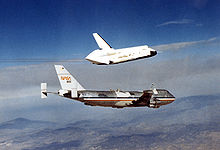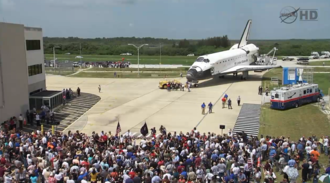STS shuttle
The Space Shuttle STS (Space Transport System) was a partially reusable NASA spacecraft for low-Earth orbit. Its name derives from a 1969 plan for a system of reusable spacecraft of which only the Shuttle was funded. The first of four orbital test flights took place on March 10, 1981, ushering in operational flights in 1982. Space Shuttles were used in 135 missions between 1981 and 2011, launched from the Kennedy Space Center (KSC) in Florida, USA Operational missions launched various satellites, interplanetary probes and the Hubble Space Telescope (HST); they conducted scientific experiments in orbit; and participated in the construction and servicing of the International Space Station (ISS). The total mission time for the Shuttle fleet was 722 days, 19 hours, 21 minutes, and 23 seconds.
Components of the Shuttles included the Orbital Vehicle (OV), a pair of solid recoverable rocket boosters (SRBs), and the expendable External Tank (ET) containing hydrogen and liquid oxygen. The Shuttles launched vertically, like a conventional rocket, with two SRBs operating in parallel with the OV's three main engines, which drew their fuel from the ET. The SRBs were ejected before the vehicle entered orbit. The ET ejected immediately before orbital insertion, which used the two Space Maneuvering System (OMS) engines. At the end of the mission, the shuttle fired its OMS to deorbit and re-enter the atmosphere. The shuttle was gliding to a landing strip located at Rogers Dry Lake at Edwards Air Force Base in California or at the Shuttle Landing Facility at KSC. After landing at Edwards, the shuttle was taken by Shuttle Carrier Plane back to KSC. This aircraft was a modified Boeing 747.
The first shuttle, Enterprise, was built for approach and landing tests and had no orbital capability. The name of this Shuttle comes from the spaceship of the same name from the science fiction series Star Trek (Trips to the Stars). Four operational orbiters were initially built: Columbia, Challenger, Discovery and Atlantis. Of these, Challenger and Columbia were destroyed in accidents during their missions in 1986 and 2003, respectively. In total 14 astronauts died. A fifth operational shuttle, Endeavour, was built in 1991 to replace Challenger. The Space Shuttle was decommissioned at the end of the last Atlantis mission on July 21, 2011.
General
Space Shuttles were partially reusable human spaceflight vehicles capable of reaching low orbit. They were used by NASA between 1981 and 2011. It was the result of Shuttle design studies conducted by NASA and the United States Air Force in the 1960s. It was initially proposed for development as part of a second generation of Systems. Space Transportation System (STS) that would follow the Apollo Program. In a September 1969 report from a space task force commanded by Vice President Spiro Agnew. The budget cut to NASA by then-President Richard Nixon after the conclusion of the Apollo Program caused the removal of all system components except for the Shuttle itself, to which NASA applied the name STS.
The vehicle consisted of a spaceplane for orbit and reentry powered by disposable tanks of hydrogen and liquid oxygen, with reusable solid rocket boosters that could be detached from the main body. The first of four orbital tests took place in 1981 and carried out operational flights beginning in 1982, all launched from the Kennedy Space Center (KSC) in Florida, USA. The system was decommissioned in 2011 after 135 missions., with Atlantis making the last takeoff of the program on July 8, 2011. The program ended when Atlantis touched down at KSC on July 21, 2011. Important missions included launching various satellites and interplanetary probes, conducting scientific experiments, and helping with the construction and servicing of space stations. The first orbiter vehicle, Enterprise, was built for initial approach and landing tests and had no engines, heat shield, or other systems necessary for orbital flight. A total of five operational shuttles were built. Of these, two were destroyed in accidents.
The Shuttles were used for orbital space missions by NASA, the US Department of Defense (DoD), the European Space Agency (ESA), Japan, and Germany. The United States funded development and operations of the Shuttles except for the Spacelab modules used in D1 and D2 by Germany. SL-J was partially funded by Japan.
For launch, the Shuttle consisted of the 'Stack', including the orange External Tank (ET) (on the first two launches the ET was white); two slim, white solid rocket boosters (SRBs).; and the Orbital Vehicle (OV), which contained the crew and payload. Some payloads were launched into higher orbits with one of two upper stages developed for the STS (one-stage Cargo Assist Module or two-stage Upper Inertial Stage). The Space Shuttle was assembled in the Vehicle Construction Building and then positioned on a mobile launch pad supported by brittle nuts on each SRB that detonated during launch.
The assembled Shuttle launched vertically like a conventional rocket. It took off on the power of its two SRBs and its three main engines, which were fueled by hydrogen and liquid oxygen from the ET. The Space Shuttle had a two-stage ascent. The SRBs provided additional thrust during takeoff and the first leg of the flight. Approximately two minutes after takeoff, the brittle nuts were detonated to release the SRBs, which descended with parachute support into the ocean to be recovered by ships for repair and reuse. The shuttle and ET would continue to climb in an increasingly level flight plan under the power of the main engines. Upon reaching a speed of 7.8 km/s the main engines would shut down. The ET, connected by two brittle nuts, was ejected and burned up in the atmosphere. After ejecting the external tank, the engines of the Space Maneuvering System (OMS) were used to adjust the orbit. The shuttle positioned astronauts and payloads such as satellites or parts of space stations in low Earth orbit. Typically between five and seven crew members traveled on the shuttle. Two crew members, the commander and the pilot were enough for a minimum flight as in the first four test flights from STS-1 to STS-4. The usual payload was around 22,700 kg but could be increased depending on the chosen launch configuration. The orbiter carried its cargo in a special compartment with opening doors along its top side, a feature that distinguished the Space Shuttle from other craft. This feature made possible the deployment of large satellites such as the Hubble Space Telescope, as well as the capture and return to Earth of heavy payloads.
As the shuttle completed its final mission it fired its OMS thrusters to de-orbit and re-enter the atmosphere. During the descent, the orbiter passed through several layers of the atmosphere and decelerated from hypersonic speeds primarily by aerobraking. In lower atmosphere and in the landing stage it was more like a glider but controlled with Reaction Control System (RCS) engines and fly-by-wire controlled hydraulically powered flight surfaces. It was landing on a long runway like a conventional plane. The aerodynamic shape was a balance between the demands of radically different speeds and air pressure during reentry, hypersonic and subsonic flight. As a consequence the orbiter had a high sink rate at low altitudes, and switched from using RCS boosters at high altitudes to flying surfaces in the low atmosphere.
Early history
Formal design of what would become the Space Shuttle began with the "Phase A" aired in the late 1960s. Conception had begun two decades earlier, even before the Apollo Program of the 1960s. One of the places from which arose the concept of a spacecraft that could return from space and make a horizontal landing it was from NACA, in 1954, in the form of an aeronautical research experiment called the X-15. The NACA proposal was presented by Walter Dornberger.
In 1958 the X-15 concept led to proposals to launch an X-15 into space, and another X-series spaceplane was proposed, the X-20 Dyna-Solar, along with other concepts and studies of space planes. Neil Armstrong was selected as the pilot for both the X-15 and X-20. Although the X-20 was never built, a spaceplane of similar design was built several years later and delivered to NASA in January 1966 under the name HL-10.
In the mid-1960s, the US Air Force conducted classified studies on next-generation space transportation systems and concluded that semi-reusable designs were the cheapest. He proposed a development schedule with an immediate start on a Class I vehicle with expendable engines, followed by slower development of a Class II semi-reusable design and possibly a Class III reusable design. In 1967, George Mueller visited the NASA base to study the options. 8 people attended and presented a wide variety of designs, including previous Air Force designs like the X-20 Dyna-Solar.
In 1968 NASA officially began work on what was then known as the Integrated Launch and Reentry Vehicle (ILRV). At the same time, NASA had an alternate competition for the Space Shuttle Main Engine (SSME). The NASA offices in Houston and Hunstville have completed a joint Request for Proposal (RFP) for ILRV studies to design a spacecraft that could send a payload into orbit but also reenter the atmosphere and thus fly back to Earth. For example, one answer was for a two-stage design that had a large booster and a small orbiter, called the DC-3, one of several Phase A Shuttle designs. Upon completion of the Phase A studies, the phases Designs were extensively evaluated by B, C, and D through 1972. In the final design, the lower portion consisted of recoverable solid rocket boosters, and the upper portion was a disposable external tank.
In 1969, President Richard Nixon decided to support the continued development of the Space Shuttle program. A series of development and test programs refined the basic design before entering final development and testing. In August 1973, the X-24B showed that a depowered spaceplane could reenter Earth's atmosphere for a horizontal landing.
European ministers met in Belgium in 1973 to authorize the West European manned orbital project and its largest contribution to the Spacelab and Space Shuttle program. Spacelab would provide a multidisciplinary orbital space laboratory and more space equipment for the Shuttle.
Description
The Space Shuttle was the first operational orbiter designed to be reusable. It carried various payloads into low-Earth orbit, provided crew rotation and supplies to the International Space Station (ISS), and provided maintenance to satellites. The orbiter could even retrieve satellites and other payloads to bring back to Earth. Each Shuttle was designed to last 100 launches or a 10-year lifespan, although this was later extended. The person in charge of designing the STS was Maxime Faget, who also helped with the design of previous spacecraft such as Mercury, Gemini and Apollo. The size and shape of the Shuttle was determined primarily by the need to accommodate the largest commercial and military satellites, as well as a 1,000-mile cross-recovery range in order to meet USAF requirements for missions classified for to be able to abort a launch and enter a polar orbit. This was the main reason for the immense size of the Shuttle wings compared to modern commercial designs, which have few control surfaces for glide. Other factors influencing the decision to go with solid rockets and a disposable tank included the Pentagon's desire for a high-lift capacity vehicle for launching satellites, and the Nixon administration's desire to reduce the cost of launching satellites. space exploration by means of spaceships with reusable components.
Each Space Shuttle was a reusable launch system comprised of three main parts: the reusable OV, the disposable ET, and two reusable SRBs. Only the OV entered orbit after ejection of the boosters and tank. The vehicle was launched vertically like a conventional rocket, and the orbiter would glide to a horizontal landing, like an airplane. In the end, any damage could be repaired and ready for the next cast. The SRBs were parachuted down into the ocean, where they could be towed to shore and repaired for reuse.
Five OVs were built: Columbia (OV-102), Challenger (OV-099), Discovery (OV-103), Atlantis (OV-104), and Endeavor (OV-105). One model, Inspiration, currently stands at the entrance to the Astronaut Hall of Fame. An additional ship, Enterprise (OV-101), was built for atmospheric glide and landing tests; it was originally planned to prepare it for orbital operations at the end of the tests, but it was determined that it would be cheaper to prepare the structural test article STA-099, which became the Challenger. In 1986 the Space Shuttle Challenger disintegrated 73 seconds after liftoff, and surviving components were used to build Endeavour as a substitute. The Endeavour cost approximately US$1.7 billion to build. The Columbia suffered a catastrophic crash over Texas during reentry in 2003. Each Shuttle launch cost about US$450 million.
Roger A. Pielke, Jr. has estimated that the Space Shuttle program through 2008 cost about $170 billion (2008 dollar value). The average cost per flight was US$1.5 billion. Two missions were paid for by Germany, Spacelab D1 and D2 with a cargo control center in Oberpfaffenhofen, Germany. D1 was the first time control cargo of an STS mission was not under American control.
Sometimes the orbiter itself was referred to as the Space Shuttle. This was not technically correct, since the Space Shuttle was the combination of the orbiter, the external tank and the two solid rocket boosters. These components, once assembled in the Vertical Assembly Building, were known as the "Stack".
Responsibility for Shuttle components was spread across multiple NASA centers. Kennedy Space Center was responsible for takeoff, landing, and return operations for equatorial orbits, Vandenberg Air Force Base was responsible for takeoff. landing and return operations for polar orbits (although this was never used). Johnson Space Center served as the central point for all Shuttle operations, Marshall Space Flight Center was responsible for the main engines, external tank and the solid rocket boosters, the John C. Stennis Space Center conducted tests of the main engines, and the Goddard Space Flight Center the global tracking network.
Orbital Vehicle
The orbiter is visually similar to a conventional aircraft, with double-delta wings swept 81° on the inboard and 45° on the outboard. Its vertical stabilizer is swept back 50°. The four flaps mounted on the trailing parts of the wings, the speed brake located at the rear of the stabilizer, along with the body flap controlled the orbiter during descent and landing.
The orbiter's cargo bay measured 4.6 by 18m, comprising the majority of the fuselage. Declassified information in 2011 showed that the cargo bay was designed by the National Reconnaissance Office specifically to dock the KH-9 HEXAGON spy satellite. Two partially symmetrical doors running the length of the bay spanned the entire top. Payloads were typically loaded horizontally while the orbiter was vertical on the launch pad, and discharged vertically in microgravity by the remote robotic arm (controlled by astronauts), astronauts in EVA, or powered by the payload itself.
The three STS Shuttle Main Engines (SSMEs) are mounted on the sides of the orbiter's rear fuselage in a triangular pattern. The engine heads can rotate 10.5° vertically and 8.5° horizontally during climb to change the direction of propulsion for maneuvering the craft. The orbiter structure is mainly made of an aluminum alloy, although the engine structure is mainly a titanium alloy.
The operational orbiters that were built were the OV-102 Columbia, OV-099 Challenger, OV-102 Discovery, OV-104 Atlantis and OV-105 Endeavour.
External tank
The primary function of the Space Shuttle external tank (ET) was to provide liquid hydrogen and oxygen fuel to the main engines. It was also the launch vehicle's spine, providing attachment points for the two solid rocket boosters and the orbiter. The ET was the only part of the STS Shuttle that was not reused. Although ETs were always ejected, it may have been possible to take them into orbit and reuse them (such as for joining a space station).
Solid Booster Rockets
Two solid rocket boosters (SRBs) gave 12,500 kN of thrust on takeoff, this was 83% of the total boost during takeoff. The SRBs were ejected two minutes after takeoff at an altitude of approximately 28 mi (45.72 km), opening their parachutes and falling into the ocean to be recovered. The SRBs' casing was made of 13 mm thick steel. The SRBs were reused. repeatedly; the encapsulation used in the Ares I engine tests in 2009 consisted of engine covers that had already flown, collectively, 48 Shuttle missions, including STS-1.
Astronauts who have flown in various spacecraft report that the Shuttle provides a bumpier ride than the Apollo program rocket or the Soyuz spacecraft. The additional vibrations were caused by solid rocket boosters, since solid fuel does not burns as constantly as liquid. The vibration subsides when the solid rocket boosters detach.
Complementary elements of the orbiter
The orbiter could be used in conjunction with a variety of add-ons, depending on the mission. This included orbital laboratories, extra rocket boosters to launch payloads into space, and many more functions given by the Extended Duration Orbiter, Multi-Purpose Logistics Modules, or Canadarm (SRMS). An upper stage called the Orbit Transfer Stage was once used. Other types of systems were part of the Spacelab modular system - pallets, igloo, IPS, etc., which also supported special missions such as the SRTM.
Spacelab
A major component of the STS Shuttle Program was Spacelab, primarily contributed by a union of several European countries, and operated in conjunction with United States and international partners. Based on a system of pressurized modules, paddles, and systems, the Spacelab missions spanned multidisciplinary sciences, orbital logistics, and international cooperation. More than 29 missions flew in topics ranging from astronomy, microgravity, radar, and life sciences, among others. Spacelab hardware also served to support the Hubble (HST) and space station resupply. STS-2 and STS-3 were tested, and the first completed mission, Spacelab-1 (STS-9), lifted off on November 28, 1983.
The Spacelab program formally began in 1973 following a meeting in Brussels, Belgium, by European leaders. Within a decade, Spacelab entered orbit and provided an orbital workshop and hardware systems for Europe and the US. International cooperation, science and exploration were achieved at the Spacelab.
Flight Systems
The Shuttle was one of the first ships to use a digital fly-by-wire flight control system. This means that there was no mechanical or hydraulic connection between the pilot control stick and control surfaces or hete RCS motors. The control algorithm was based on a classical Proportional Derivative Integral (PID) methodology.
One concern with using digital fly-by-wire systems was the possibility of failure. Much research was done on the Shuttle's computer system. The Shuttle used five redundant IBM 32-bit General Purpose Computers (GPCs), model AP-1'1, constituting a type of embedded system. Four computers used specialized software called the Primary Avionics Software System (PASS). A fifth backup computer used separate software called the Backup Flight System (BFS). He referred to computers collectively as Data Processing System (DPS).
The goal of the Shuttle DPS design was fail-operational/fail-safe confidence. After a single failure, the Shuttle could continue the mission. After two misses he could still land safely.
The four GPCs operated on the go, checking each other out. If one gave a different result than the other three (for example, if one failed), the three functional computers "voted" for the other three. to get it out of the system. This isolated him from vehicular control. If a second computer failed, the two still functional voted to remove it as well. A highly unlikely failure would have been for two of the computers to give an 'A' result, and the other two to give a 'B' result. In this unlikely case one of the two pairs was chosen at random.
BFS was separately developed software used on the fifth computer, used only if the primary system of four computers failed. The BFS was created because even though the four primary computers were redundant in hardware, they all used the same software; so a generic problem in the software could crash the whole system. Avionics embedded systems software was developed under completely different conditions than commercial software: the number of lines of code was tiny compared to a publicly available commercial product, system changes were infrequent and extensive testing, and many people from Programming and testing worked on a small amount of computer code. Despite this, in theory it could still have failed, and the BFS existed to cover that contingency. While the BFS could run parallel to the PASS, the BFS never took control over the PASS during a mission.
The software for the Shuttle flight computers was written using a high-level language called HAL/S (High-Level Assembly Language/Shuttle), similar to PL/I (Programming Language/One). It was specifically designed for a real-time embedded systems environment.
IBM AP-101 computers originally had approximately 424 KB of central magnetic memory each. The CPU could process around 400,000 instructions per second, they did not have a hard drive, and they loaded their software from magnetic tape cartridges.
In 1990 the original computers were replaced by an improved model AP-101S, which had about 2.5 times the memory capacity (about 1MB) and three times the processing speed (about 1.2 million of instructions per second). The memory was changed from a magnetic core to a battery-backed semiconductor.
The first Shuttle missions, beginning in November 1983, carried with them a Grid Compass, considered one of the first portable computers. The GRiD was given the name SPOC (Shuttle Portable On-Board Prdemator). Their use on the Shuttle required hardware and software modifications that were incorporated into later versions of the commercial product. It was used to monitor and display the Shuttle's ground position, the path of the next two orbits, where the Shuttle would have line-of-sight communication with ground stations, and to determine points for Earth observations at specific points. The Comprass did not sell well, costing at least US$8,000, but it offered unmatched performance for its size and weight. NASA was one of its main customers.
Orbiter markings and insignia
The Enterprise prototype orbiter originally had a US flag on the upper surface of the left wing and the letters "USA" in black on the right wing. The name "Enterprise" it was painted black on the cargo bay doors above the hinge and behind the crew module; at the aft end of the bay doors was the NASA logo known as the "worm" (worm) in grey. Beneath the bay doors at the rear was the text 'United States'; in black with a US flag on the front.
The first operational orbiter, Columbia, originally had the same markings as Enterprise, but the letters "USA" on the right wing they were slightly larger and further apart. The Columbia also had black markings that the Enterprise did not have on its upper RCS module, around the cockpit windows, and on its vertical stabilizer.
The Challenger established a modified marking scheme for the Shuttle fleet that was reused by the Discovery, "Atlantis and Endeavour. The letters "USA" in black above the American flag moved to the left wing, with the "worm" of NASA in gray centered above the orbiter name on the right wing. The orbiter name was moved to a position on the forward fuselage just below and behind the cockpit windows. This allowed the name of the Shuttle to be visible when photographed in space with the bay doors open.
In 1983, the markings on the Enterprise were modified to match those of the Challenger, and the NASA logo was repainted black. Some black markings were added to the nose, cockpit, windows, and vertical tail to more closely resemble the flying vehicles, but the name "Enterprise" he held his position at the bay doors, as there was no need to open them. The Columbia name was moved to the front of the fuselage to match the other vehicles after the STS-61-C, during the fleet hiatus from 1986 to 1988 following the loss of the Challenger, but kept its original wing markings until its last refit (after STS-93). Since 1998, vehicle markings changed to incorporate the traditional NASA logo known as the "meatball" (meatball). The "worm" logo, which the agency had removed, was removed from the cargo bay doors and the "meatball" was added to the stern of the text "United States" in the lower fuselage. The "meatball" it was also placed on the left wing, with the American flag above the orbiter's name, positioned to the left, rather than centered, on the right wing. The three surviving flying vehicles, the Discovery, the Atlantis, and the Endeavour, still bear these markings in their respective museums. The Enterprise became the property of the Smithsonian Institution in 1985 and was not under NASA control when these changes were made, so it still bears the 1983 markings.
Updates
The Space Shuttle was initially developed in the 1970s, but received many updates and modifications to improve its performance, reliability, and safety. Internally, the Shuttle remained very similar to its original design, except for the upgraded flight computers. Aside from computer improvements, the original analogue primary instruments were replaced with modern, full-color flat-panel monitors, called the glass cockpit, which is similar to that of modern aircraft. To facilitate the construction of the ISS, the airlocks of all orbiters except Columbia were replaced by an external docking system to have more space for cargo that would be stored on the ISS. middle deck of the Shuttle during station resupply missions.
The Space Shuttle Main Engines (SSMEs) were upgraded several times to increase their power and reliability. This explains phrases like "Main engines accelerating at 104%." This did not mean that the engines were pushing beyond their limit. The 100% figure was the original power level. During the development program, Rocketdyne determined that the engine was capable of operating safely and reliably at 104% of its original throttle. NASA decided to use notation greater than 100% since rescaling the number would mean modifying the computer software, among other things.
During the first two missions, STS-1 and STS-2, the external tank was painted white to protect the insulation that covered the majority of the tank, but improvements and testing determined this was not necessary. The weight saved in not painting the tank resulted in a higher carrying capacity. Further weight was saved by removing some "stringers" internals in the hydrogen tank that turned out to be unnecessary. The lightweight external tank that resulted from eliminating these components first flew on STS-6 and was used for most Shuttle missions. An improved version was first installed and used on STS-1. This version was made of a 2195 aluminum-lithium alloy. It weighed 3.4 metric tons less than previous tanks, allowing the Shuttle to carry heavy items to ISS high orbit. As the Shuttle could not be operated without a crew, these improvements were first tested in operational flights.
Solid accelerators have been improved as well. Design engineers added a third O-ring to the joint between the segments after the Space Shuttle Challenger disaster.
Many more updates to the SRB were planned to improve its performance and security, but never came to fruition. These culminated in the considerably simpler, cheaper, safer, and better performing solid rocket. These rockets went into production in the early 1990s to support the Space Station, but were canceled to save money after spending $2.2 billion. The loss of the ASRB program resulted in the development of the External Tank. superlight (SLWT), which improved cargo capacity despite not improving safety. In addition to this, the US Air Force developed their own design for a much lighter SRB rocket using a filament system, but this too was cancelled.
The STS-70 mission was delayed in 1995 when woodpeckers blew holes in the foam insulation of the Discovery External Tank. NASA has since installed dummy owls that must be removed prior to launch. The delicate nature of the insulation foam had been the cause of damage to the orbiter's Thermal Protection System, heat shield, and thermal wrap. NASA stated that this damage, despite being responsible for the Space Shuttle Columbia disaster on February 1, 2003, would not affect the completion of the ISS on schedule.
A variation of the Shuttle that would only carry payloads into space had been proposed and rejected since the 1980s. It was known as the C-Shuttle, and would trade reusability for payload capacity, with great potential savings from reusing technology designed for the Space Shuttles. Another proposal was to convert the cargo bay into a passenger area, with versions ranging from 30 to 74 seats, three days in orbit, and priced at US$1.5 million per seat.
On the first of four Shuttle missions, astronauts wore modified US Air Force full-pressure high-altitude suits, which included a full-pressure helmet during ascent and descent. From the fifth flight until the loss of Challenger, light blue one-piece nomex suits with partial-pressure helmets were used. A version of the high-altitude suits modified to partial-pressure and less cumbersome was reintroduced when flight restarted in 1988. This suit, known as the Takeoff-Entry Suit, ended its service life in late 1995, and was replaced by the Advanced Crew Escape Suit (ACES), which resembled the Gemini mission spacesuit in design, but retained the orange color of the Launch-Entry suit.
To extend the duration that orbiters could stay anchored to the ISS, the Station-to-Shuttle Power Transfer System (SSPTS) was installed. The SSPTS allowed these orbiters to use power provided by the ISS to preserve their consumables. The SSPTS was used successfully for the first time on STS-118.
Specifications
Orbiter (for the Endeavour, OV-105)
- Length: 37.2 m
- Width of wings: 23,8 m
- Height: 17,2 m
- Vacuum weight: 78,017,8 kg
- Gross takeoff weight (orbiter): 108,862,1 kg
- Maximum landing weight: 104.326.2 kg
- Charge upon landing (return charge): (14,400 kg)
- Maximum charge: 25.061 kg
- Load to LEO 204 km, 28.5° inclination: 27,500 kg
- Load to LEO (407 kg, 51.6° to ISS): 16,05 kg
- Charge to GTO: 3805.6 kg
- Post to polar orbit: 12,700.6 kg
- Charging bay dimensions: 4,6x18 m
- Operational Altitude: 90 to 960 km
- Speed: 7,743 m/s (27,870 km/h)
- Main stage (SSME with external tangue)
- Motors: three Rocketdyne II Block SSMEs, each with a sea level acceleration of 1,752 kN to 104% power.
- Force (by taking off at sea level, 104% power, with the three engines): 5,255 kN
- Specific impulse: 4.46 km/s
- Burning duration: 480 s
- Fuel: Liquid hydrogen/ Liquid oxygen
- Orbital manoeuvre system
- Motors: 2 WHO rockets
- Force: 53.4 kN total vacuum acceleration
- Specific impulse: 3,10 km/s
- Burning duration: 150–250 s burnt typical; 1,250 s burnt des-orbital
- Fuel: MMH/N2O4
- Triple: varies.
- The first ferry flights had a minimum crew of two; many subsequent missions changed it to five. By the end of the program, they would typically fly seven crew members; (commander, pilot, several mission specialists, one of which (MS-2) was designated the flight engineer starting with STS-9 in 1983). On two occasions, eight astronauts flew (STS-61-A, STS-71). The shuttle could accommodate eleven people in case of an emergency (see STS-3x).
External tank (for SLWT)
- Length: 46.9 m
- Diameter: 8.4 m
- Propeller volume: 2.025 m3
- Vacuum weight: 26.535 kg
- Gross takeoff weight (tank): 756,000 kg
Solid booster rockets
- Length: 45,46 m
- Diameter: 3.71 m
- Vacuum weight (each): 68,000 kg
- Gross takeoff weight (each): 571,000
- Force (by taking off, at sea level, each): 12,500 kN
- Specific impulse: 269 seconds
- Duration of the burner: 124 s
Pillar of the system
- Height: 56 meters
- Gross takeoff weight: 2,000,000 kg
- Total takeoff force: 30.160 kN
Mission Profile
Preparing for takeoff
All Space Shuttle missions were launched from the Kennedy Space Center (KSC). Weather criteria for takeoff included, but were not limited to: precipitation, temperatures, cloud cover, thunder forecast, wind, and humidity. The Shuttle did not launch under conditions where it could be struck by lightning. Aircraft are commonly struck by lightning without adverse effects as the electricity is dispersed over its conductive structure and the aircraft is not connected to an electrical ground. Like most aircraft, the Shuttle was constructed primarily of conductive aluminum, which would normally protect internal systems. However, during takeoff the Shuttle left behind a vapor line that could connect the ship to electrical ground. NASA's Anvil Rule for shuttle takeoff stated that no anvil cloud could appear within a distance of 18.52 km. The Shuttle Takeoff Weather Officer monitored weather conditions until announced. the final decision to cancel the takeoff. In addition to this, for liftoff, weather conditions had to be acceptable at one of the Transatlantic Abort Landing sites (one of many abort modes for Space Shuttles) as well as the solid rocket booster recovery area. While the Shuttle might have been struck by lightning, such a situation caused problems on Apollo 12, so to ensure the safety of the crew and the mission, NASA decided not to launch the Shuttle if there was a chance that it could be struck. lightning strikes (NPR8715.5).
Historically, the Shuttle would not launch if its flight lasted between December and January (transition year, or YERO). Its flight software, designed in the 1970s, was not designed for this, and would require the orbiter's computers to be reset at the turn of the year, which could cause an in-orbit problem. In 2007, NASA engineers created a solution so that the Shuttles could cross the border at the end of the year.
Launch
After the final pause in the countdown, at T-minus 9 minutes, the Shuttle went through its final preparations for launch, the countdown being automatically controlled by the Ground Launch Sequencer (MCG), the software at the Launch Control Center, which would stop counting if a critical problem was detected with any of the systems on board the Shuttle. The GLS reported to the Shuttle's onboard computers at T-minus 31 seconds, in a process called the autostart sequence.
In T-minus 16 seconds, the Massive Sound Suppression System (SPS) began dousing the Mobile Launch Pad (MLP) and SRB trenches with 1,100 m³ of water to protect the Orbiter from damage caused by the acoustic energy of the rocket reflected from the MLP during liftoff.
In T-minus 10 seconds, hydrogen igniters were activated in each engine bell to quench stagnant gas within the cones prior to ignition. Failure to burn these gases could ignite onboard sensors and create the possibility of excessive pressure, and even vehicle explosion during the ignition phase. The rocket's main pumps also began to charge the combustion chambers with liquid hydrogen and oxygen. The computers responded to this action by allowing the redundant computers to initiate the burn phase.
The three main rockets (SSMEs) launched in T-6.6 seconds. The main rockets were fired sequentially by general purpose computers (GPCs) at 120ms intervals. The three SSMEs were required to reach 90% of maximum force within 3 seconds, otherwise the on-board computers would initiate an RSLS abort. If all three rockets indicated nominal performance for T-3 seconds, they would receive the command to enter liftoff configuration and the command would be sent to prepare the SRBs for firing at T-0. Between T-6.6 seconds and T-3 seconds, while the SSMEs were firing but the SRBs were still attached to the platform, the difference in force caused the launch stack to rotate 35cm measured at the tip of the external tank. The 3 second delay after the confirmation of operation from the SSME was to allow the stack to return to a near vertical position. At T-0 seconds, the 8 brittle nuts holding the SRBs to the platform detonated, the SSMEs accelerated to 100% force, and the SRBs ignited. By T+0.23 seconds, the SRBs accumulated enough force to begin takeoff, reaching their maximum internal pressure at T+0.6 seconds. The JSC Mission Control Center assumed control of the flight once the SRBs were in place. free from the launch tower.
Shortly after liftoff, the Shuttle's main rockets were accelerating to 104.5% and the vehicle was beginning a roll maneuver that positioned it on the correct trajectory (azimuth) for the planned orbital inclination, and in a prone position with wings level. The Space Shuttle flew upside down during climb to allow a trim angle of attack that was favorable to aerodynamic loads during the high dynamic pressure region, resulting in a positive net load factor, as well as providing the crew with a view of the horizon that you could use as a visual reference. The vehicle climbed in a progressively flatter arc, accelerating as the mass of the SRBs and ET decreased (while using fuel). To reach a low orbit requires a horizontal acceleration much greater than the vertical.
About 30 seconds into the climb, the power of the SSMEs was reduced - usually to 72%, although this varied - to reduce the aerodynamic forces acting on the Shuttle at a point called Max Q. Additionally, the grain design of propellant from the SRBS caused its strength to decrease by 30% within 50 seconds of starting the climb. Once Orbiter management verified that Max Q would be within the Shuttle's structural limits, it would throttle back to 104.5%; the action of decreasing and then increasing force was known as the "bucket of force" (thrust bucket). To maximize performance, the force level and timing of the force bowl was tailored to bring the Shuttle as close to its aerodynamic limits as possible.
At around T+126 seconds, pyrotechnic adjusters ejected the SRBs and small separation rockets pushed them laterally away from the vehicle. The SRBs were parachuted down into the ocean to be reused. The Shuttle would then continue to accelerate towards orbit with its main rockets. Acceleration at this point was typically around 0.9 G, and the vehicle would angle slightly above the horizon - it used its three main rockets to gain and then maintain its altitude as it accelerated horizontally towards its orbit. About 5.75 minutes into the climb, the direct communication lines to ground were fading, so the Shuttle turned upside down to reconnect its communication lines to the Tracking and Information Relay Satellite system.
About 7 1/2 minutes into the climb, the mass of the vehicle was low enough that the engines needed to be derated to limit the vehicle's acceleration to 3. The Shuttle would maintain this acceleration for the next minute, and the main rocket cutoff (MECO) occurred around 8½ minutes after launch. The main rockets were shut down before the propellant was completely depleted, as running out could damage the rockets. The oxygen supply was turned off before the hydrogen supply, as SSMEs reacted negatively to other turn off models. A few seconds after MECO, the ET was ejected by pyrotechnic adjusters.
At this point in the flight, ET and the Shuttle were on suborbital trajectories, hovering toward their apogee. Once there, about half an hour after MECO, the Shuttle's OMS rockets were fired to increase perigee and reach orbit, while ET fell back to Earth toward the Indian Ocean or Pacific Ocean, depending on the weather. launch profile, and burned up in the atmosphere. ET was designed in such a way that it would break up, explode, and disintegrate during its re-entry to ensure that any pieces that fell to Earth would be small.
Ascent Tracking
The Shuttle was monitored during its climb by tracking short-range (10 seconds before takeoff to 57 seconds after), medium-range (7 seconds before takeoff to 110 seconds after), and long-range (7 seconds before takeoff). up to 165 seconds later).
Short-range cameras included 12 16mm cameras on the MLP and 8 16mm cameras on the Fixed Service Structure, 4 high-speed still cameras located on the perimeter of the launch complex in addition to 42 motion picture still cameras 16mm.
Medium-range cameras included remotely operated tracking cameras at the launch complex plus 6 sites along the coast to the immediate north and south of the pad, each with an 800mm lens and high-speed cameras running at 100 frames per second. These cameras only ran for 4-10 seconds due to limitations in the amount of tape available.
Long-range cameras included those mounted on the External Tank (ET), the SRBs, and the Orbiter itself, which transmitted live video back to earth, providing valuable information on any debris that fell during ascent. Long-range tracking cameras with 400-inch tapes and 200-inch lenses were operated by a photographer at Playa Playalina as well as at 9 other sites from 61 km north at Ponce Inlet to 37 km south at Ponce Inlet. Patrick Air Force Base (PAFB), and additional mobile optical tracking cameras could be placed on Merritt Island during launches. A total of 10 high-definition cameras were used both to obtain ascent information for engineers and for television networks such as NASA TV and HDNet. The number of cameras was increased considerably and existing cameras were upgraded on the recommendation of the Columbia Accident Investigation Board to provide more information on debris during launch. Additionally, during the first two flights after the loss of the Columbia and its crew, a pair of NASA WB-57 reconnaissance aircraft equipped with high-definition video and infrared cameras flew at 60,000 feet. to provide more views of the takeoff climb. KSC also invested nearly US$3 million in upgrades to video analytics systems in support of debris tracking.
In orbit
Once in orbit, the Shuttle usually flew at an altitude of 200 miles above sea level, and occasionally up to 400 miles. In the 1980s and 1990s, many flights involved science missions at NASA's Spacelab /ESA, or the launch of various types of satellites and scientific probes. By the 1990s and turn of the century, the focus had shifted more to ISS maintenance, with fewer satellite launches. Most missions involved staying in orbit for several days or even weeks, although longer missions were possible using a component called the Extended Duration Orbiter or by staying attached to a space station.
Reentry and Landing
The vehicle began its re-entry by firing the OMS rockets while flying upside-down, rear-forward, in the opposite direction of its orbit for approximately three minutes, which slowed the Shuttle by about 200 miles /h. This caused the perigee of the Shuttle's orbit to be lowered to Earth's upper atmosphere. The Shuttle would then flip over.
The vehicle was beginning to pass through increasingly dense air in the lower thermosphere at about 122 km, while traveling at nearly mach 25 (8,200 m/s). The vehicle was controlled by a combination of RCS thrusters and control surfaces, to fly at a 40° nose-up angle, producing very large drag which not only slowed the Shuttle, but also reduced heating. for re-entry. As the vehicle encountered progressively denser air, it began a transition from spacecraft to aircraft. In a straight line, your 40° upward angle would cause your angle of descent to flatten out or even rise. To prevent the vehicle from climbing again, it performed a series of S-shaped turns, each lasting several minutes and having a 70° angle horizontally, while maintaining its 40° vertical angle. This way it dissipated speed horizontally instead of vertically. This occurred during the hottest phase of re-entry, when the heat shield glowed red and G-forces were at a maximum. By the end of the last turn, the transition to aircraft was almost complete. The vehicle leveled its wings, lowered its nose to a light dive, and began its approach to the landing zone.
The orbiter's maximum glide/lift-to-drag ratio varies considerably with its speed, ranging from 1:1 at hypersonic speeds, 2:1 at supersonic speeds, and reaching 4.5:1 at subsonic speeds during approach and landing. landing.
In the lower atmosphere, the orbiter flies almost like a conventional glider, except for its much higher rate of descent, at more than 50 m/s. At approximately mach 3, two air probes, located on the left and right sides of the orbiter's lower fuselage, are deployed to detect air pressure related to the vehicle's movements in the atmosphere.
Final approach and landing stage
When the approach and landing phase began, the orbiter was at an altitude of 3,000m and 12km from the runway. The pilots applied aerodynamic brakes to help slow the vehicle down. The orbiter's speed decreased from approximately 682 to 346 km/h upon touchdown (compared to 260 km/h for a commercial aircraft). To assist with the speed brakes, a 12 meter drag chute was deployed when the vehicle (having already touched down the runway) was at approximately 343 km/h. The parachute was ejected when the orbiter slowed down to 110 km/h.
 Wikimedia Commons hosts a multimedia category STS Shuttle.
Wikimedia Commons hosts a multimedia category STS Shuttle.
Post-landing processing
After landing, the rover would stay on the runway for several hours so the orbiter could cool down. Teams at the front and rear of the orbiter were testing for the presence of hydrogen, hydrazine, monomethylhydrazine, dinitrogen tetroxide, and ammonia. If hydrogen was detected, an emergency was declared, the orbiter was shut down, and teams would evacuate the area. An escort of 25 specially designed vehicles and 150 trained engineers and technicians would approach the orbiter. Purge and vent lines would be attached to remove toxic gases from the fuel lines and cargo bay around 45-60 minutes after landing. A flight surgeon boarded the orbiter for initial crew medical checks before disembarking. Once the orbiter crew had disembarked, responsibility for the vehicle was transferred from the JSC to the KSC.
If the mission ended at Edwards Air Force Base in California, White Sands Spaceport in New Mexico, or any other landing strip that could use an orbiter in an emergency, the orbiter was loaded on top of the orbiter's Transport Aircraft. Space Shuttle, a modified 747, to transport the Shuttle back to KSC, landing at the Shuttle Landing Facility. Once the Shuttle was at the Shuttle Landing Facility, the orbiter was towed 3.2 km along a special road and roads normally only accessed by visiting trucks and KSC employees until it reached the Orbiter Processing Facility, where he began a preparation process that lasted months to be ready for his next mission.
Landing sites
NASA preferred the Space Shuttles to land at KSC. If weather conditions did not permit, the Shuttle could delay its landing until conditions were favorable, land at Edwards Air Force Base, California, or use one of several alternate landing sites around the world. A landing anywhere other than KSC meant that after landing, the Shuttle would have to be attached to the aircraft that would transport it back to Cape Canaveral. The Space Shuttle Columbia (STS-3) once landed at Spaceport White Sands, New Mexico; this was seen as a last resort as NASA scientists believed that the sand could damage the exterior of the Shuttle.
There were several alternate landing sites that were never used.
Contributors to risk
An example of a technical risk analysis for an STS mission is SPRS iteration 3 highest risk contributors for STS-133:
- Orbital micrometeorite debris (MMOD)
- Catastrophic failure caused by the Space Shuttle Main Cohete
- Ascent scoops hit TPS carrying LOCV in arbit or re-entry
- Crew error during re-entry
- RSRM-induced catastrophic failure (RSRM is the engines of the SRBs rocket)
- COPV failure (COPVs are internal orbiter tanks containing high-pressure gas)
An internal NASA risk assessment (performed by the Space Shuttle Program Safety Assurance Office at JSC) published in late 2010 or early 2011 concluded that the agency had seriously underestimated the risks involved with operate the shuttle. The report assessed that there was a 1 in 9 chance of catastrophic failure during the Shuttle's first 9 flights, but that subsequent Shuttle upgrades improved the risk to 1 in 90.
History of the fleet
This is a list of major events in the Space Shuttle orbiter fleet.
| Date | Orbiter | Event / commentary |
|---|---|---|
| 17 September 1976 | Enterprise | STS Shuttle Enterprise he left the assembly facilities in Southern California and presented himself to a audience of thousands of people. |
| 18 February 1977 | Enterprise | First flight, attached to the ferry cargo aircraft throughout the flight |
| 12 August 1977 | Enterprise | First free flight; lined cone, landing on dirt track. |
| 26 October 1977 | Enterprise | Last Free Flight Enterprise; first landing on the cement/asphalt track of the Edwards Air Force Base. |
| 12 April 1981 | Columbia | First flight Columbia, first orbital flight test; STS-1 |
| 11 November 1982 | Columbia | First operational flight of the STS Shuttle, first mission to take four astronauts;STS-5 |
| 4 April 1983 | Challenger | First flight Challenger; STS-6 |
| 30 August 1984 | Discovery | First flight Discovery; STS-41-D |
| 3 October 1985 | Atlantis | First flight Atlantis; STS-51-J |
| 30 October 1985 | Challenger | First crew of eight astronauts; STS-61-A |
| 28 January 1986 | Challenger | Deploy 73 seconds after takeoff; STS-51-L; the seven crew members died. |
| 29 September 1988 | Discovery | First post-Challenger; STS-26 |
| 4 May 1989 | Atlantis | First STS Shuttle mission to launch an interplanetary probe, Magellan. |
| 24 April 1990 | Discovery | Launch of Hubble Space Telescope; STS-31 |
| 7 May 1992 | Endeavour | First flight Endeavour; STS-49 |
| 19 November 1996 | Columbia | Longest Shuttle Mission lasting 17 days and 15 hours; STS-80 |
| 4 December 1998 | Endeavour | First mission to ISS; STS-88 |
| 1 February 2003 | Columbia | It was uninformed during the re-entry; STS-107; the seven crew members died. |
| 25 July 2005 | Discovery | First post-Columbia; STS-114 |
| 24 February 2011 | Discovery | Last flight Discovery; STS-133 |
| 16 May 2011 | Endeavour | Last mission EndeavourSTS-134 |
| 8 July 2011 | Atlantis | Last flight Atlantis and a Space Shuttle; STS-135 |
Sources: NASA launch manifest, NASA Space Shuttle archive
Ship disasters
On January 28, 1986, Challenger disintegrated 73 seconds after launch, due to failure of the right SRB, killing all seven astronauts on board. This disaster was caused by the low-temperature deficiency of an O-ring, in a mission-critical seal between the SRB housing segments. The failure of an internal O-ring allowed burning hot gases to explode, repeated warnings by design engineers expressing concern about the lack of evidence of O-rings when the temperature was below 12° C had been ignored by NASA administrators.
On 1 February 2003, the Columbia disintegrated during re-entry due to launch damage to the leading edge of the carbon-carbon composite wing, killing to his team of seven people. Control engineers had made three separate requests for high-resolution images taken by the Department of Defense that would have provided an understanding of the extent of the damage, while the defense chief Thermal Protection System (TPS) engineer requested that the astronauts aboard Columbia be allowed to leave the vehicle so that the damage could be inspected. NASA managers intervened to stop DoD assistance and were denied the spacewalk request, thus the viability of astronaut repair or rescue by Atlantis scenarios. it was not considered by NASA management at the time.
Withdrawal
NASA retired the space shuttle in 2011, after 30 years of service. The Shuttle was originally conceived and presented to the public as a "space truck", which was to, among other things, be used to build a United States space station in low-Earth orbit in the early 1990s. United States space station became the ISS project, which suffered from long delays and design changes before it could be completed, the service life of the space shuttle was extended several times until 2011, serving at least 15 years longer than originally designed. Discovery was the first of NASA's three remaining Space Shuttles to be retired.
The last Space Shuttle mission was originally scheduled for late 2010, but the schedule was later extended to July 2011, when Michael Suffredini of the ISS program said an additional trip was needed in 2011 to deliver pieces to the International Space Station. The final Shuttle mission consisted of just four astronauts - Christopher Ferguson (commander), Douglas Hurley (pilot), Sandra Magnus (mission specialist 1), and Rex Walheim (mission specialist 2); The 135th Space Shuttle mission took place and the last aboard Atlantis, which was launched on July 8, 2011 and landed safely at the Kennedy Space Center on July 21, 2011. 2011 at 5:57 PM m. EDT (09:57 GMT).
Distribution of orbiters and other parts
NASA announced that it would transfer the orbiters to educational institutions or museums at the conclusion of the Space Shuttle program. Each museum or institution is responsible for covering the price of preparing and transporting each vehicle for display. 20 museums from around the US submitted proposals to receive one of the retired orbiters. NASA also made blocks of the Space Shuttle thermal protection system available to schools and universities for less than US$25 each. About 7,000 blocks were available, limited to one per institution.
On April 12, 2011, NASA announced the selection of locations for the remaining Shuttle orbiters:
- Atlantis is on display at the KSC Visits Complex, near Cabo Cañaveral, Florida. He arrived at the complex on November 2, 2012.
- Discovery arrived at the Udvar-Hazy Center of the Smithsonian Institute's National Air and Space Museum in Chantilly, Virginia, near Washington, D.C. on April 19, 2012.
- Endeavour was delivered to the California Science Center in Los Angeles, California on October 14, 2012.
- Enterprise (Atmospheric Testor) was in exhibition at the Udvar-Hazy Center of the National Air and Space Museum, but moved to the Museum of the Sea-Aire-Espacio Intrepid of New York City in the middle of 2012
Flight and training hardware will be taken from the Johnson Space Center and will go to the National Air and Space Museum and the National Museum of the United States Air Force. The complete fuselage mockup, including the cargo bay and aft section, but without wings, will go to the Museum of Flight in Seattle. the Mission Simulation and Training Institution's stationary simulator will go to Chicago's Adler Planetarium, and the motion simulator will go to Texas A&M's Department of Aerospace Engineering in College Station, Texas. Other simulators used in Shuttle astronaut training will go to the Wings of Dreams Aviation Museum in Starke, Florida and the Virginia Air and Space Center in Hampton Virginia.
In August 2011, NASA's Office of Inspector General (OIG) published a "NASA Review of Location Monitor Selection for the Space Shuttle Orbiter", the review had four main conclusions:
- "The Nasa's decisions regarding the placement of the Orbiter were the result of an agency that created processes that emphasized above any other consideration on the location of the Orbiters in their place where most people have the opportunity to see them";
- "The team made several mistakes during the evaluation process, including one that would have resulted in a numerical "start" between the Intrepid, the Kennedy Visits Complex, and the National Museum of the United States Air Force (Aerial Force Museum) in Dayton, Ohio";
- "There is no evidence that the recommendation team or the Administrator's decision were contaminated by political influence or any other inappropriate consideration";
- "Some of NASA's decisions were made during the selection process – specifically, its decision to handle the selection aspects as if it were a competitive public procurement and to delay the announcement of its placement decisions until April 2011 (more than 2 years after its first request for information from interested entities) – this can intensify challenges to the Agency and those selected as they work to complete the placement process the Orbiters in their new homes. "
The NASA OIG had three recommendations, saying NASA should:
- "Extremely review the financial, logistical and sample plans of the recipients to ensure that they are viable and consistent with the objectives, processing schedules and delivery with the Education Agency";
- "Make sure that receivers' payments are closely coordinated with processing schedules, not to prevent NASA's ability to efficiently prepare Orbiters to show up at the museum, and provide sufficient funds before doing the job";
- "Work in close collaboration with host organizations to minimize delays in delivery on the calendar that could increase Agency costs or affect other NASA missions and priorities. "
In September 2011, the CEO and two board members of the Seattle Museum of Flight met with NASA Administrator Charles Bolden, pointing out "significant mistakes in deciding where to place its four retired Space Shuttles& #3. 4;; alleged errors include inaccurate information about attendance at the Museum of Flight, as well as the layout of the Intrepid Space-Sea-Air Museum exhibit site.
Successors to the space shuttle and its legacy
Until another US crewed spacecraft is ready, teams will travel to and from the International Space Station (ISS) exclusively aboard the Russian Soyuz spacecraft.
A planned successor to the STS Shuttle was the "Shuttle II", during the 1980s and 1990s, and later the Constellation program during the 2004-2010 period. The CSTS was a proposal to continue commercially operating STS Shuttles, after NASA. In September 2011, NASA announced the design selection for the new STS that will launch the Orion spacecraft and more hardware for missions beyond. of a low Earth orbit.
The Commercial Orbital Transport Services program began in 2006 with the purpose of creating commercially operated unmanned cargo vehicles to service the ISS. The Commercial Crew Development (CCDev) program began in 2010 to create commercial spacecraft, capable of delivering at least four crew members to the ISS, to stay connected for 180 days, and then return to Earth again. These craft would have been operational by the 2010s.
In culture
Space Shuttles have appeared in both fiction and nonfiction, from children's movies to documentaries. Early examples include the 1979 James Bond film, Moonraker; Activision's 1982 video game Space Shuttle: A Journey Into Space; and G. Harry Stine's 1981 novel Shuttle Down. In the 1986 film SpaceCamp, Atlantis is accidentally launched into space with a group of US Space Camp participants on board. In the 1995 video game The Dig, developed by the company LucasArts, the shuttle Atlantis participated in the mission to transport astronauts to the asteroid. The 1998 film Armageddon showed a combined crew of oil workers and US military piloting two modified Shuttles to avoid the destruction of Earth by an asteroid. The 2013 film Gravity features the fictional Space Shuttle Explorer, whose crew crashes under a shower of space debris while traveling at high speed. In addition, the Star Trek franchise named the main ship of the Star Trek: Discovery series Discovery in thanks to NASA naming the first shuttle Enterprise, after the famous ship.
The Space Shuttle has also been converted into various toys and models; for example, a model of the Lego Space Shuttle was built by visits to the Kennedy Space Center, and smaller models have been sold commercially as a standard "LegoLand" set. The Space Shuttle also appears in various flight simulators and space flight simulators such as: Microsoft Space Simulator, Orbiter, FlightGear, and X-Plane.
US Postal Commemorations
The US Portal service has published several postal versions showing the Space Shuttle. The first of these stamps was published in 1981, and they are on display at the National Postal Museum.
Contenido relacionado
Corvus (constellation)
CAD
SQL

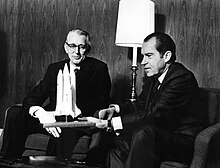

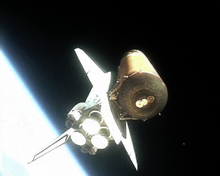
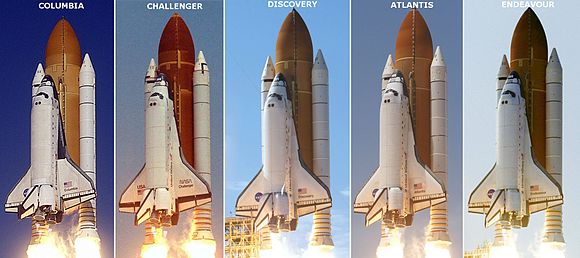


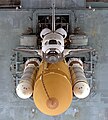
![Se libera agua sobre la plataforma de lanzamiento móvil 39A al inicio de una prueba de sistemas de supresión de sonido en 2004. Durante el lanzamiento, 350,000 galones de agua caen en la plataforma en 41 segundos.[32]](https://upload.wikimedia.org/wikipedia/commons/thumb/9/9e/Sound_suppression_water_system_test_at_KSC_Launch_Pad_39A.jpg/120px-Sound_suppression_water_system_test_at_KSC_Launch_Pad_39A.jpg)


